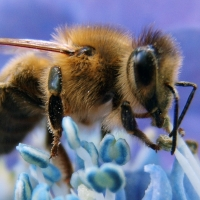Focus is on Pesticides as 80,000 Bee Colonies Damaged or Destroyed

Around 80,000 honeybee colonies, imported by farmers in the San Joaquin Valley to pollinate almond trees, have been damaged or destroyed and the search for what happened keeps leading back to pesticides.
The Sacramento Bee reported last week that 75 growers met with the U.S. Environmental Protection Agency (EPA) last March and three-quarters of them said they had significant damage. Bee keepers indicated they thought the problem could very well be related to a practice by farmers of “tank mixing” multiple pesticides, including a couple of new ones: tolfenpyrad and cyantraniliprole. Suspicions were also raised about the spraying of insecticides during the day while bees were foraging.
Beekeepers would like to see regulations that recognize tank mixing and daytime spraying as problems, with warning labels for the former and a ban on the latter. The state Department of Pesticide Regulation (DPR) would like to study the matter more.
California produces 82% of the world's almonds on about 800,000 acres of land from Tehama County to Kern County. The nuts were the state's No. 1 agricultural export in 2012 at $2.5 billion, more than double that of wine. Farmers have been switching to almonds from other crops, like cotton, as the price doubled over the last five years. That may slow as California's ongoing drought highlights the crop's relatively high water requirements.
Around 1,300 bee keepers bring more than 1.2 million colonies to California to pollinate the state's almond trees annually, accounting for 75% of the bees used locally. The bees are then used to pollinate dozens of other fruit, vegetable and field crops. Farmers have been importing more bees of late as a worldwide die-off of bees that began a decade ago has scientists scrambling for answers.
Disease, genetics, parasites, loss of habitat and other environmental causes besides pesticides are all currently under investigation. Meanwhile, one-third of the honeybees in the U.S. have disappeared. More than 30% of honeybee colonies in the United States collapsed during the 2012-2013 winter, a 42% increase over the year before, according to a report by the U.S. Department of Agriculture in collaboration with the Apiary Inspectors of America and The Bee Informed Partnership.
Last January, Daniel Sumner, director of the Agricultural Issues Center at UC Davis, explained to the Los Angeles Times what it would take for water-deprived California's to cease growing almonds: “We'll run out of dirt and water before we run out of almond markets.”
You might add honeybees to that list.
–Ken Broder
To Learn More:
Beekeepers Search for Answers as Colonies Show up Damaged after Almond Farm Pollination (by Edward Ortiz, Sacramento Bee)
What Chemicals Are Sprayed on Local Almonds? (by Anne Hart, The Examiner)
California Farms Lead the Way in Almond Production (by David Pierson, Los Angeles Times)
Beekeepers Sue EPA over Failure to Protect Bees from Pesticides (by Noel Brinkerhoff, AllGov)
Almost One-Third of Honey Bee Colonies in U.S. Collapsed in Just 6 Months (by Noel Brinkerhoff and Danny Biederman, AllGov)
- Top Stories
- Controversies
- Where is the Money Going?
- California and the Nation
- Appointments and Resignations
- Unusual News
- Latest News
- California Forbids U.S. Immigration Agents from Pretending to be Police
- California Lawmakers Urged to Strip “Self-Dealing” Tax Board of Its Duties
- Big Oil’s Grip on California
- Santa Cruz Police See Homeland Security Betrayal in Use of Gang Roundup as Cover for Immigration Raid
- Oil Companies Face Deadline to Stop Polluting California Groundwater





